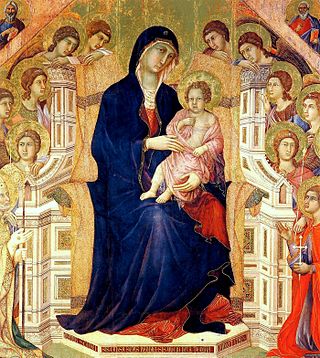
Duccio di Buoninsegna, commonly known as just Duccio, was an Italian painter active in Siena, Tuscany, in the late 13th and early 14th century. He was hired throughout his life to complete many important works in government and religious buildings around Italy. Duccio is considered one of the greatest Italian painters of the Middle Ages, and is credited with creating the painting styles of Trecento and the Sienese school. He also contributed significantly to the Sienese Gothic style.

Sansepolcro, formerly Borgo Santo Sepolcro, is a town and comune founded in the 11th century, located in the Italian Province of Arezzo in the eastern part of the region of Tuscany.

The Monastery of the Holy Saviour at Lecceto in Tuscany, was the principal House of the order of the Hermit Friars of Saint Augustine in 1256, when Pope Alexander IV constituted the Augustinian order internationally. It was dedicated to Jesus as Saviour.

Monteriggioni is a comune in the province of Siena in the Italian region of Tuscany. It borders on the communes of Casole d'Elsa, Castellina in Chianti, Castelnuovo Berardenga, Colle di Val d'Elsa, Poggibonsi, Siena, and Sovicille. The town is architecturally and culturally significant; it hosts several piazzas, and is referenced in Dante Alighieri's Divine Comedy.

Castelnuovo Berardenga is a comune (municipality) in the province of Siena in the Italian region Tuscany, located about 50 kilometres (31 mi) southeast of Florence and about 14 kilometres (9 mi) east of Siena. Since 1932 it has been included in the Chianti wine-production area.
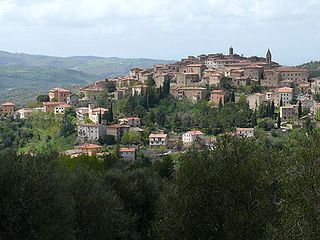
Seggiano is a comune (municipality) in the Province of Grosseto in the Italian region Tuscany, located about 100 kilometres (62 mi) south of Florence and about 40 kilometres (25 mi) northeast of Grosseto.

The Abbey of Sant'Antimo is a former Benedictine monastery located in Castelnuovo dell'Abate, in the comune of Montalcino, Tuscany, central Italy. It is approximately 10 km from Montalcino about 9 km from the Via Francigena, the pilgrim route to Rome. After many years of disuse, the abbey was reoccupied in 1992 by a small community of Premonstratensian Canons Regular. Since January 2016, the occupants are a community of monks of the Olivetan Benedictine order.

The Badia a Settimo or Abbazia dei Santi Salvatore e Lorenzo a Settimo is a Cluniac Benedictine abbey in the comune of Scandicci, near Florence in Tuscany, Italy. It was founded in 1004.

The Territorial abbey of La Trinità della Cava, commonly known as Badia di Cava, is a Benedictine territorial abbey located near Cava de' Tirreni, in the province of Salerno, southern Italy. It stands in a gorge of the Finestre Hills.
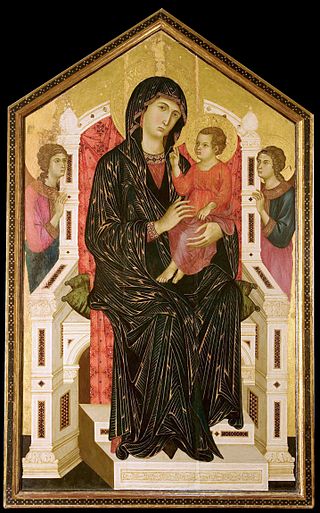
The Master of Badia a Isola was an Italian painter. His name is taken from a depiction of the Madonna and Child that hangs in the Badia dei Santi Salvatore e Cirino in Abbadia a Isola, located near Monteriggioni, a comune in the province of Siena; a number of other paintings by his hand are also believed to exist.
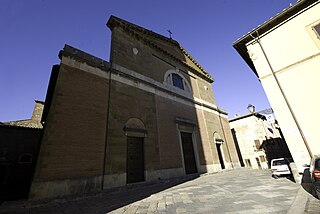
Colle di Val d'Elsa Cathedral is a Roman Catholic cathedral in Colle di Val d'Elsa, Tuscany, Italy. Anciently a pieve of the Holy Saviour, it is now dedicated to Saints Albert and Martial. Formerly the episcopal seat of the Diocese of Colle di Val d'Elsa from its creation in 1592, it is now a co-cathedral of the Archdiocese of Siena-Colle di Val d'Elsa-Montalcino.

Montalcino Cathedral is a Roman Catholic cathedral in Montalcino in the province of Siena, Italy. Formerly the seat of the bishops of Montalcino, since 1986 it has been a co-cathedral in the Archdiocese of Siena-Colle di Val d'Elsa-Montalcino. It is dedicated to the Holy Saviour.
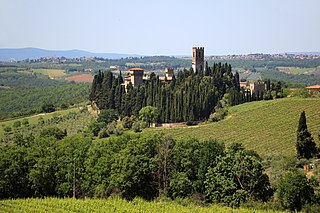
The Badia di Passignano, also called the Abbey of San Michele Arcangelo a Passignano is a historic Benedictine abbey located atop a scenic hilltop, surrounded by cypresses, east of the town of Tavarnelle Val di Pesa, Province of Florence, Italy. The abbey complex is located about 2 kilometres east of the Siena-Florence autostrada. The settlement is also a frazione of Barberino Tavarnelle.

San Michele degli Scalzi is a church located in Piazza San Michele degli Scalzi, in the eastern part of Pisa, Italy. It had also been known as the church of San Michele degli Scalzi in Orticaia, referring to the swampy nature of the site at the time of its founding. The term Scalzi refers to the barefoot monks linked to the church. Dating back to the 11th century, it has been restored several times in the original Romanesque style.
Francesco Nasini was an Italian painter of the Baroque period, active mainly in towns outside of Siena, Italy.

The Monastery of San Girolamo in Campansi is a former convent located on Via Campansi #18 in the city of Siena, region of Tuscany, Italy. The Baroque-style church still stands as an independent chapel; while the monastery has been converted to a nursing home for the elderly. There is a separate Monastery of San Girolamo on via San Girolamo, located in a different contrada of Siena.

Santa Maria e Santa Brigida al Paradiso is a Roman Catholic parish church located on via Benedetto Fortini in the quartiere of Gavinana in the zone of Paradiso, just south of the urban center of Florence, region of Tuscany, Italy. The church is also known as Santi Maria e Brigida alla Badiuzza di Fabroro

Abbadia a Isola is a village in Tuscany, central Italy, administratively a frazione of the comune of Monteriggioni, province of Siena. At the time of the 2001 census its population was 136.
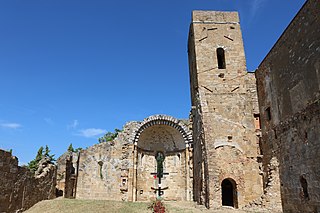
The Abbey of the Holy Savior and of Sts. Justin and Clement, also known as the Camaldolese Abbey of St. Justin, is a former Italian monastery in the city of Volterra, Pisa, which was founded in the 11th century. It was a major religious institution of the region until it was initially abandoned by the monks due to earthquake damage in the 19th century and then taken over and dissolved under the Risorgimento movement for the political unification of the Italian peninsula. For most of its history, it operated as a monastery of Camaldolese monks.


















